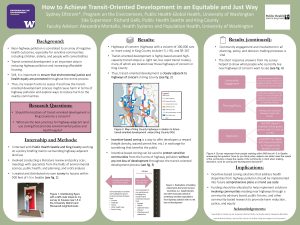How to Achieve Transit-Oriented Development in an Equitable and Just Way
Transit-oriented development is an important step in reducing highway pollution, making cities more walkable, and increasing accessibility. However, it will be a long process and it is important to ensure that harm is still reduced until the positive impacts are realized. Over the summer, I interned with Public Health Seattle and King County working on a policy briefing memo surrounding highway-adjacent land use. This included research on future development patterns in King County and how much of it will be closely adjacent to highways. Further, it involved researching relevant and practical zoning solutions aimed at protecting sensitive communities from highway pollution exposure. To accomplish this, I conducted a literature review, policy scan and utilized a GIS analysis. I also consulted with specialists in the fields of public health, environmental science, and policy. Lastly, I conducted a short survey that I distributed to residents living within 500 feet of high-volume highways in the University District and Roosevelt neighborhoods. Findings show that current and future transit-oriented development is closely adjacent to high-volume highways. Zoning solutions aimed at environmental justice and health equity can be an important way to reduce the harms of highway pollution, such as incentive-based zoning and overlay zones, which should still be accompanied by other non-zoning solutions. Utilizing these zoning solutions for future highway-adjacent development will assist in reducing harm to sensitive populations in King County and beyond while still allowing the process of transit-oriented development, which is an important step in reducing highway pollution overall, to continue.
